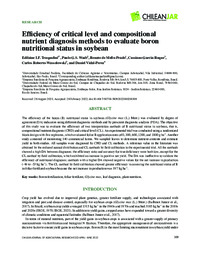Efficiency of critical level and compositional nutrient diagnosis methods to evaluate boron nutritional status in soybean.
Efficiency of critical level and compositional nutrient diagnosis methods to evaluate boron nutritional status in soybean.
Autoria: TRASPADINI, E. I. F.; WADT, P. G. S.; PRADO, R. de M.; ROQUE, C. G.; WASSOLOWSKI, C. R.; PEREZ, D. V.
Resumo: The efficiency of the boron (B) nutritional status in soybean (Glycine max (L.) Merr.) was evaluated by degree of agreement (DA) indicators using different diagnostic methods and by prescient diagnostic analysis (PDA). The objective of this study was to evaluate the efficiency of two interpretation methods of B nutritional status in soybean, that is, compositional nutrient diagnosis (CND) and critical level (CL). An experimental trial was conducted using a randomized block design with five replicates, which evaluated foliar B application rates of 0, 300, 600, 1200, and 1800 g ha-1 . Another study consisted of monitoring 140 commercial farms. We sampled leaves to determine nutrient contents and estimate yield in both studies. All samples were diagnosed by CND and CL methods. A reference value in the literature was obtained by the reduced normal distribution and CL methods by field calibration in the experimental trial. All the methods showed a high DA between diagnoses; the efficiency ratio and accuracy for true deficiency were both low, except for the CL method by field calibration, which exhibited an increase in positive net yield. The DA was ineffective to validate the efficiency of nutritional diagnoses; methods with a higher DA showed negative values for the net increase in production (-46 to -53 kg ha -1). The CL method by field calibration showed greater efficiency in assessing the nutritional status of B in foliar fertilized soybean because the net increase in production was 197 kg ha-1.
Ano de publicação: 2022
Tipo de publicação: Artigo de periódico
Unidade: Embrapa Rondônia
Palavras-chave: Adubação, Boro, Boron fertilizers, Diagnóstico foliar, Fertilizante, Foliar fertilizer, Glycine Max, Leaf diagnosis, Nutrição Vegetal, Plant nutrition, Planta
Observações
1 - Por padrão são exibidas publicações dos últimos 20 anos. Para encontrar publicações mais antigas, configure o filtro ano de publicação, colocando o ano a partir do qual você deseja encontrar publicações. O filtro está na coluna da esquerda na busca acima.
2 - Para ler algumas publicações da Embrapa (apenas as que estão em formato ePub), é necessário ter, no celular ou computador, um desses softwares gratuitos. Sistemas Android: Google Play Livros; IOS: iBooks; Windows e Linux: software Calibre.
Acesse outras publicações
Acesse a Base de Dados da Pesquisa Agropecuária (BDPA) para consultar o acervo completo das bibliotecas da Embrapa.

